
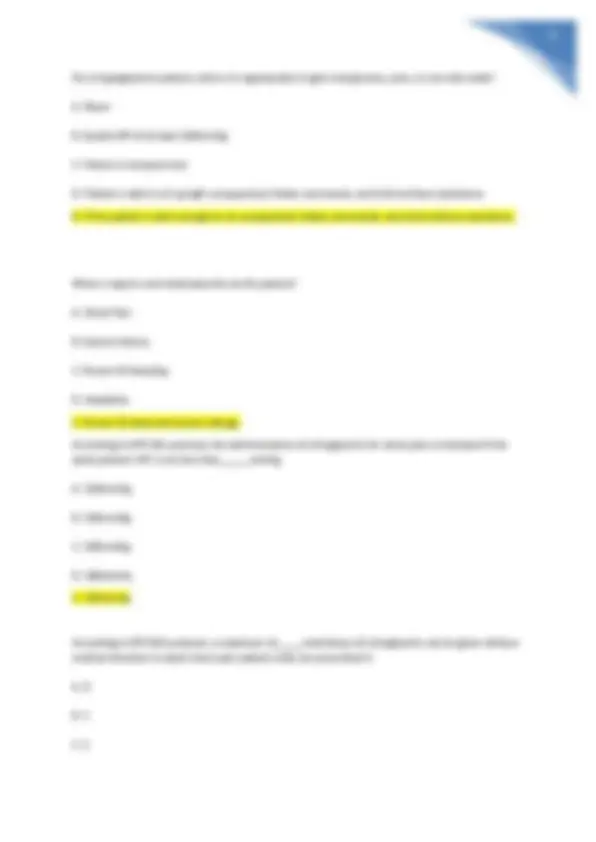
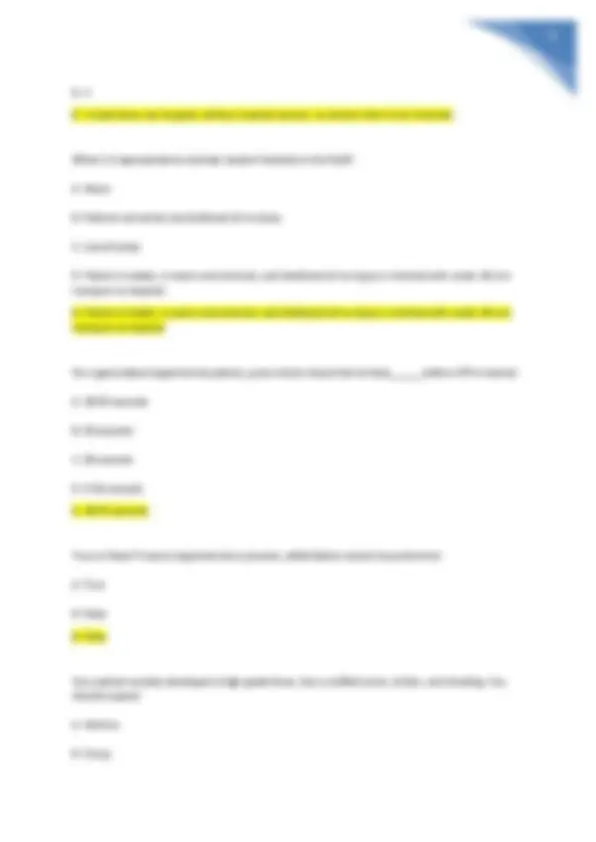
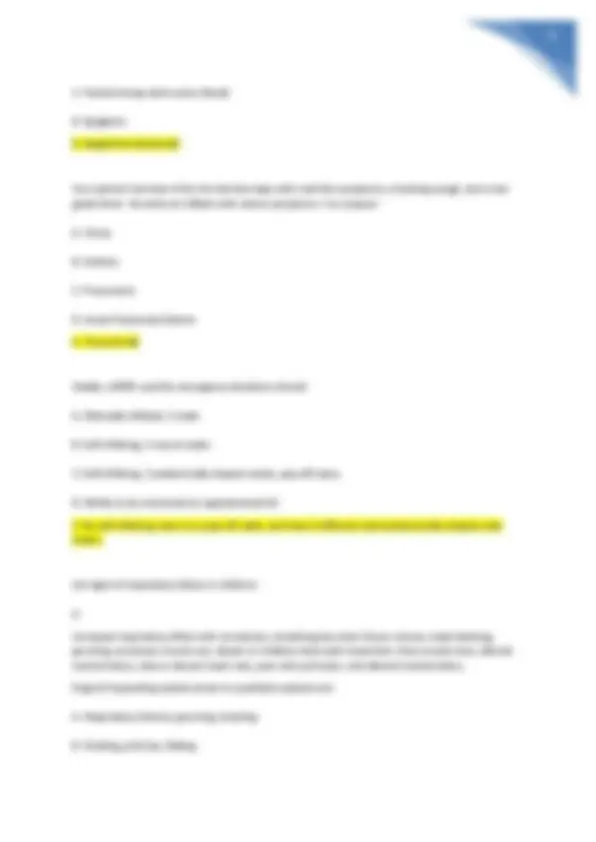
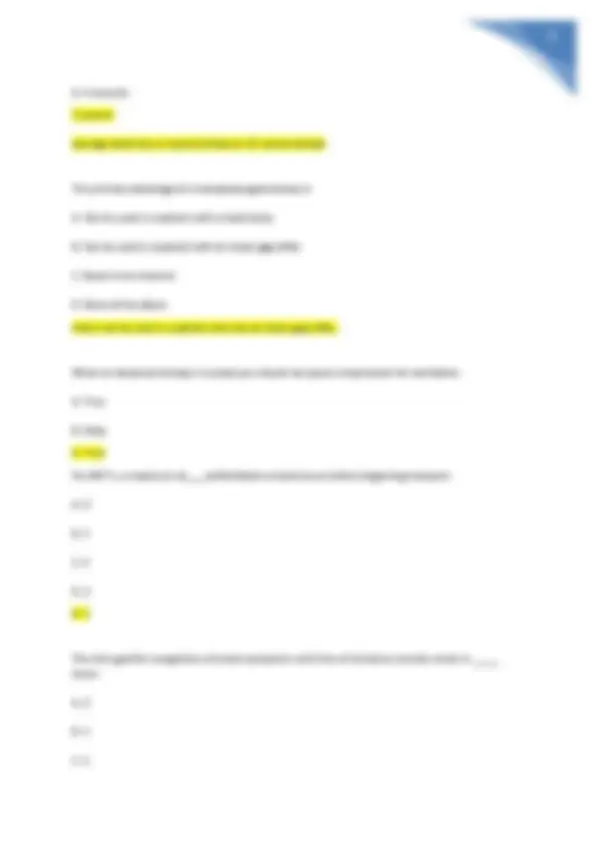
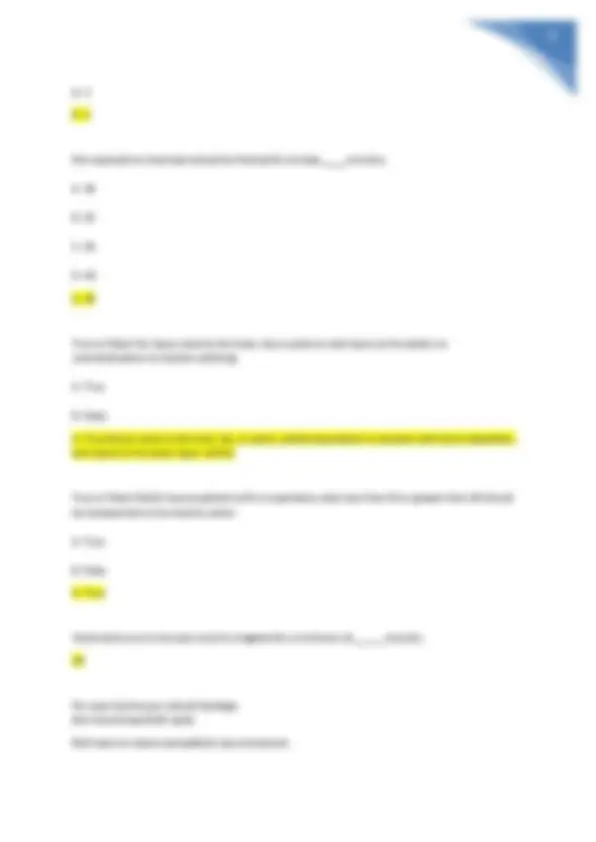
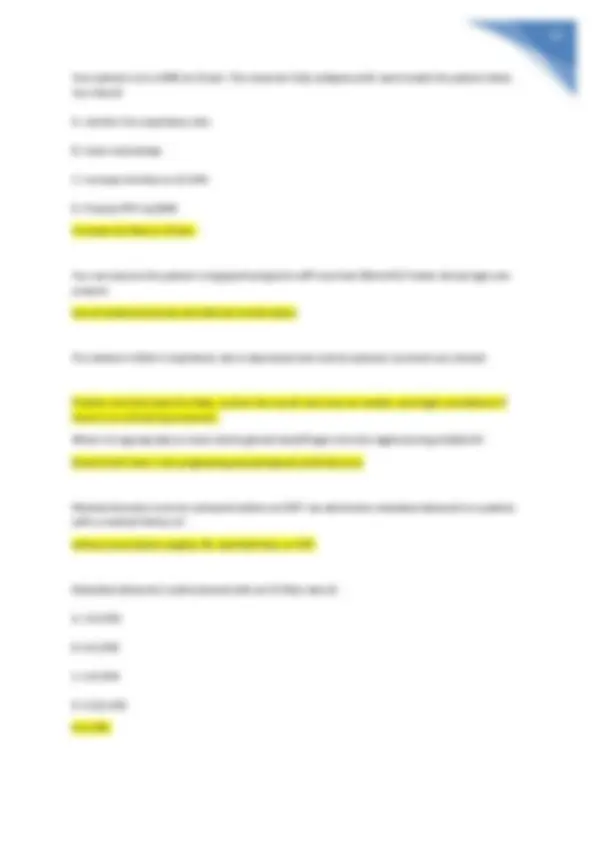


Study with the several resources on Docsity

Earn points by helping other students or get them with a premium plan


Prepare for your exams
Study with the several resources on Docsity

Earn points to download
Earn points by helping other students or get them with a premium plan
Community
Ask the community for help and clear up your study doubts
Discover the best universities in your country according to Docsity users
Free resources
Download our free guides on studying techniques, anxiety management strategies, and thesis advice from Docsity tutors
A series of questions and answers related to emergency medical services (EMS) and the New York State (NYS) EMT exam. It covers topics such as patient responsiveness, vital signs, abuse reporting, HIPAA, respiratory failure, and advanced airway management. The document also includes information on administering nebulized albuterol, hyperventilation, and infectious disease exposures. The questions are designed to help students prepare for the NYS EMT exam and review key concepts in EMS.
Typology: Exams
1 / 12

This page cannot be seen from the preview
Don't miss anything!







Your patient responds to your voice with incomprehensible murmurers. Using the AVPU scale, he is classified as responsive to:
A. Alert
B. Verbal
C. Painful stimuli
D. Unresponsive
B. Verbal stimuli
Do vitals signs have to be taken on-scene in every situation?
A. Yes
B. No
B. No. Vitals should be taken en-route for patients identified as high priority for immediate transport for definitive care.
What does SAMPLE stand for?
A. Signs and symptoms, allergies, medications, past medical history, last bowel movement, events leading to current state.
B. Signs and symptoms, allergies, movement, past medical history, last meal, events leading to current state.
C. Signs and symptoms, allergies, medications, past medical history, last meal, events leading to current state
D. None of the above
C. Signs and symptoms, allergies, medications, past medical history, last meal, events leading to current state.
What forms of abuse are EMS providers mandated to report?
A. Possession of controlled substance, Intoxication, child, spouse, and elder abuse.
B. Child injured while playing sports,
C. Elderly patient who fell in skilled nursing facility
D. Suspected child abuse, elderly patient with no food in the home, suspected spousal abuse
D. Child, Spouse, and Elder Abuse must be reported on the PCR/E-PCR and verbally at transfer of care. Child abuse must also be reported according to NYS Bureau of EMS Policy #02-01.
Does a PCR/E-PCR have to be completed when no patient contact is made?
A. No
B. Yes
B. Yes, even for stand-bys, calls where no patients are located, cancellations, and events.
What does HIPAA stand for?
A. Health Insurance Privacy, and Accountability act of 1996
B. Health Insurance Portability and Accountability Act of 1996
Health Insurance Portability and Accountability Act of 1996.
When reporting responsiveness, EMS providers should use to avoid less clear descriptors.
A. AVPU
B. CUPS
C. DCAPBTLS
D. SSNT
A. AVPU
Alert, Verbal, Painful Stimuli, Unresponsive
D. 3 total doses can be given without medical control. no shorter then 5 min intervals
When is it appropriate to actively rewarm frostbite in the field?
A. Never
B. Patients extremity has likelihood of re-injury
C. Loss of pulse
D. Patient is stable, in warm environment, and likelihood of re-injury is minimal with under 30 min transport to hospital
D. Patient is stable, in warm environment, and likelihood of re-injury is minimal with under 30 min transport to hospital
For a generalized hypothermia patient, pulse checks should last at least before CPR is started.
A. 30-45 seconds
B. 60 seconds
C. 90 seconds
D. 5-10 seconds
A. 30 - 45 seconds
True or False? if severe hypothermia is present, defibrillation cannot be performed.
A. True
B. False
B. False
Your patient acutely developed a high grade fever, has a muffled voice, stridor, and drooling. You should suspect:
A. Asthma
B. Croup
C. Partial Airway obstruction (food)
D. Epiglottis
D. Epiglottitis (bacterial)
Your patient has been ill for the last few days with cold like symptoms, a barking cough, and a low grade fever. He woke at 3:00am with severe symptoms. You suspect:
A. Croup
B. Asthma
C. Pneumonia
D. Acute Pulmonary Edema
A. Croup (viral)
Ideally, a BVM used for emergency situations should:
A. Manually inflated, 1 mask.
B. Self-inflating, 2 round masks.
C. Self-inflating, 2 anatomically shaped masks, pop-off valve.
D. Ability to be connected to supplemental O
C. Be self-inflating, have no a pop-off valve, and have 2 different sized anatomically shaped clear masks.
List signs of respiratory failure in children:
A.
increased respiratory effort with retractions, breathing less than 10 per minute, head bobbing, grunting, accessory muscle use, absent or shallow chest wall movement, limp muscle tone, altered mental status, slow or absent heart rate, poor skin perfusion, and altered mental status.
Sings of impending cardiac arrest in a pediatric patient are:
A. Respiratory distress, grunting, drooling
B. Choking, pink lips, flailing
For a patient who has ingested a poison, you should contact:
A. Poison Control
B. Medical Direction
C. Supervisor
D. Hazmat Technician
B. Medical Direction (Poison Control can not give treatment orders to EMS providers.)
Before an advanced airway is placed, during CPR the adult patient should be ventilated every - seconds to a rate of - breaths per minute.
A. 6-8 seconds (14-16 bpm)
B. 3-5 seconds (12-20 bpm)
C. 2-3 seconds (18-20 bpm)
D. 10-12 seconds (5-6 bpm)
B. 3 - 5 seconds (12- 20 bpm)
After an advanced airway is placed, the adult patient should be ventilated every - seconds to a rate of - breaths per minute.
A. 6-8 seconds (14-16 bpm)
B. 3-5 seconds (12-20 bpm)
C. 2-3 seconds (18-20 bpm)
D. 10-12 seconds (5-6 bpm)
B. 3 - 5 seconds (12- 20 bpm)
During rescue breathing, each breath should be given over:
A. 1 second
B. 2 seconds
C. 3 seconds
D. 4 seconds
1 second.
average adult has a 1 second inhale to 3 - 5 second exhale
The primary advantage of a nasopharyngeal airway is:
A. Can be used in a patient with a head injury
B. Can be used in a patient with an intact gag reflex
C. Easier to be inserted
D. None of the above
that it can be used in a patient who has an intact gag reflex.
When an advanced airway is in place you should not pause compression for ventilation.
A. True
B. False
A. True
For EMT's, a maximum of defibrillations should occur before beginning transport.
A. 5
B. 3
C. 6
D. 2
B. 3
The time goal for recognition of stroke symptoms until time of arrival at a stroke center is hours.
A. 5
B. 3
C. 1
Your patient is on a NRB at 12 lpm. The reservoir fully collapses with each breath the patient takes. You should
A. monitor the respiratory rate
B. Insert oral airway
C. Increase the flow to 15 LPM.
D. Provide PPV via BVM
Increase the flow to 15 lpm.
You can assume the patient is hypoperfusing with a BP less than 90mmHG if what clinical signs are present:
loss of peripheral pulses and altered mental status
If a newborn infant's respiratory rate is depressed and central cyanosis is present you should:
Position and stimulate the baby, suction the mouth and nose as needed, and begin ventilations if there is no clinical improvement.
When is it appropriate to insert sterile gloved hand/fingers into the vagina during childbirth?
Breech birth that is not progressing and prolapsed umbilical cord.
Medical direction must be contacted before an EMT can administer nebulized albuterol to a patient with a medical history of:
without prescription angina, MI, dysrhythmias, or CHF.
Nebulized albuterol is administered with an O2 flow rate of:
A. 2-4 LPM.
B. 4-6 LPM
C. 6-8 LPM
D. 8-12 LPM
4 - 6 LPM.
It grants immunity to anyone abandoning an infant (5 days old or less) at a safe place. This can be
Your patient has a GCS of 14. He is refusing to go to the hospital despite being told that he may have serious internal injuries due to the mechanism of injury he sustained. You should:
Request police and contact medical direction. GCS must be 15 to be considered mentally competent to refuse care.
Your patient has hemophilia fell from a ladder. On your arrival his wife is preparing to administer an infusion of his prescribing clotting factor concentrate. You should:
Allow her to proceed, and contact medical control if transport may be delayed.
Hyperventilation causes a in CO2 levels whcih in turn causes the blood vessels of the brain to .
decrease, constrict
A single episode of or significantly increases moratility due to head trauma.
hypoxia, hypotension
Pediatric AED patches are designed for use on children years of age.
1 - 8
Potential infectious disease exposures must be reported to you agencies:
Infection Control Officer.
According to NYS policy, who can consent to or refuse medical care for themself:
Any person who is 18 years of age, or is pregnant or the parent of a child, or who has married
What is the Abandoned Infant Protection Act
How long does an EMS provider have to submit written documentation of suspected child abuse or neglect?
A. 12 hours
done anonymously, and requires that someone is immediately notified of where the baby was left.